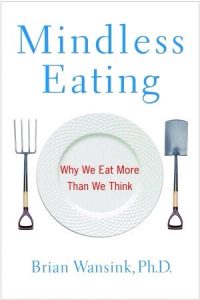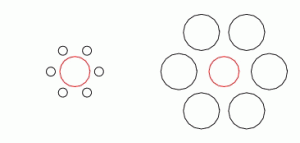Here’s the scene:
You’re out to dinner with friends. It’s been a lovely dinner; you’ve really enjoyed the evening and have gotten completely swept up in the conversation. The server comes over to start clearing the plates & dishes. As he approaches you, and asks whether you’re finished, you look down at your plate. What do you see? What do you say?
Is there food still on your plate? Are you finished eating?
 I am reading this great book called Mindless Eating. The author, Brian Wansink, a food researcher at Cornell, says that if you asked folks, “How do you know when you’re done eating?” or, “How do you know when to eat?” you’d think that most would answer these two questions with ‘I eat when I’m hungry; and I stop when I’m satisfied.’ But that’s not the case. Far too often we eat for other reasons.
I am reading this great book called Mindless Eating. The author, Brian Wansink, a food researcher at Cornell, says that if you asked folks, “How do you know when you’re done eating?” or, “How do you know when to eat?” you’d think that most would answer these two questions with ‘I eat when I’m hungry; and I stop when I’m satisfied.’ But that’s not the case. Far too often we eat for other reasons.
In the book, he exposes how we’re tricked into eating for reasons other than hunger, or overeating when we don’t mean to.
I totally identify with the idea that we often eat for reasons other than hunger. I grew up as the youngest child in a family of 8: 2 parents, 5 girls, 1 boy.
When I think about my earliest memories of the dinner table, or eating with my family, it’s pretty chaotic. It was all for one, and one for all. If I didn’t eat quickly, and get my second helpings first, with 7 other hungry mouths, I wasn’t getting any.
Additionally, with 6 kids, my parents were pretty disciplined in our daily routines. So we ate at the same time every day. And because we didn’t have money to waste, (and in our family food equated money) we all had to finish what was on our plates. ‘Eat your spinach. You know, there are starving children in Africa,’ my mom would say.
And my mom was the definition of an emotional eater.
I know that for years, I ate because of an emotional response, it was time to eat, and either cleaned my plate, or went back for seconds and ate until I was full. Not just satisfied, but past satisfied on the hunger scale, and FULL.
Because the question I was asked at the end of dinner wasn’t, ‘Are you finished?’ Or ‘Have you had enough?’ But rather, ‘Are you full?’
How that question is asked, is so important. And so, this type of conditioning as a child had a HUGE influence on my eating patterns as an adult, and led to some pretty unhealthy attitudes towards food in adulthood.
Okay, so back to the research. We know that there are two different types of cueing that determine when we start eating, what we eat, and when we stop. We have internal and external reasons for eating. We may not even be aware of these cues – especially the external ones! But once you start getting clued in, you can make better choices for yourself.
Internal Cues
- Stop eating when you’re satisfied
- Eating when you’re hungry
- Stop eating when the food doesn’t taste good any longer
External Cues
- Eat according to time of day
- Eating because it’s there (you know what I’m talking about – that stale mix that’s on the table that you’re eating even though you don’t like it)
- Stop eating because television show is over
- Stop eating because plate is clean/there’s no more left
- Stopping eating because everyone else at the table is done eating
- Matching your eating speed to the eating speed of others you’re dining with
Here’s what the research has to say about folks who eat due to internal cues versus external cues: Folks who eat according to their internal cues tend to be leaner than folks who eat according to external cueing.
Okay. So, that’s good to know. BUT does that mean that if you’re out of touch with your internal hunger cues, and you only eat because of those external reasons, that you’re doomed? No. BUT there are some things that you can do to trick yourself:
- Portion out less – If you’re someone who struggles with being a member of the clean plate club, or the deprive/binge cycle, this trick might work for you. Our brains and stomachs don’t really know the difference between 20% more, 20% less, and normal portioning out of foods. So, if you’re having pasta for dinner, and your partner gave you 20% less on your plate than you normally eat, you really wouldn’t be able to tell the difference, hunger wise.
- Make it appear like more – Consider this optical illusion.

the middle circles in both patterns is the same size In both of these patterns, the center circle is the same size. But it looks bigger in the left pattern because the surrounding circles are smaller. How you can apply this same logic to your eating, is to eat off of smaller bowls and plates. Think about it: an egg in the middle of a 14″ dinner plate will look smaller than that same egg on an 8″ salad plate.
- Create more volume – I am a HUGE fan of this trick, because I’m a volume eater. For smoothies, you can create the appearance of more volume by letting the smoothie blend longer. THis will create more air, and the appearance of more volume. The other way to in corporate this into your cooking is to add more vegetables to the dish.
- Reduce your variety – This is a great strategy for buffets and parties.We eat more when we have more variety. So, the way to cut the amount of food you eat, is to reduce the number of foods that you’re exposed to in one meal time. The first two bites of a food taste the best, and from there, we tend to get bored with what we’re eating. So, if you can limit the number of flavors you’re exposed to, you’ll consume less. Example: Cake = awesome. Ice cream = awesome. Cake+ice cream? Not as awesome.
- Surround yourself with slow eaters – I know. This one can be a toughie. Research shows that we automatically pace ourselves to match the eating pace of our dinner companions. So, if you eat with slow eaters, you’ll naturally slow down. The danger comes with eating with folks who eat their food quickly. Since it takes our stomach about 20 minutes to tell our brain that we’re satisfied, the more slowly we eat, the less food we will have eaten at that 20 minute mark.
It’s best to eat according to your hunger cues. But that can take a lot of time and practice. It also takes a lot of mental focus (something that we don’t always have later in the day).
So, while you’re practicing eating towards your internal hunger cues, these are a few ways that you can minimize the damage. Follow the tips above to limit the amount of mental energy you spend thinking about your food.
Because we have more important things to think about. Like solving world peace. Or why waist trainers are even a thing.
**
My inner circle gets access to my best stuff. Stuff that’s even better than this! I know. Can you believe that there’s more? If you’re not on the sign up HERE to gain FREE access.
You’ll learn how to change your relationship with food, your body, and realize that what you eat doesn’t determine whether or not you are a good/bad person.
And you don’t have to torture yourself with celery sticks and rice cakes (unless you’re into that kind of thing). 😉
* Mindless Eating is an affiliate link to Amazon.com